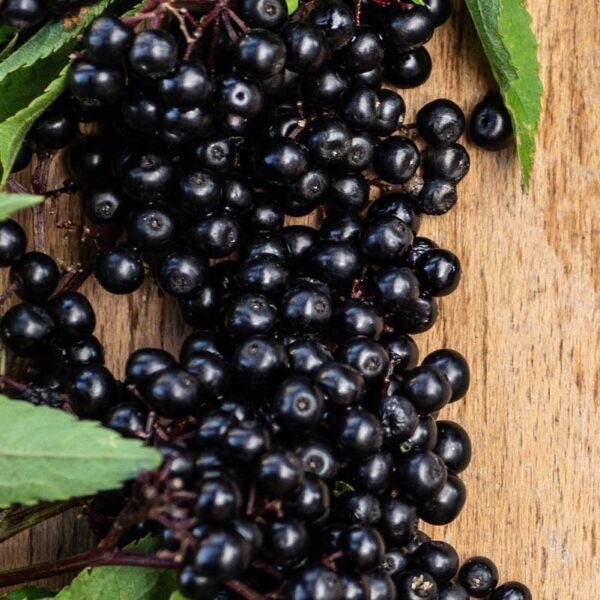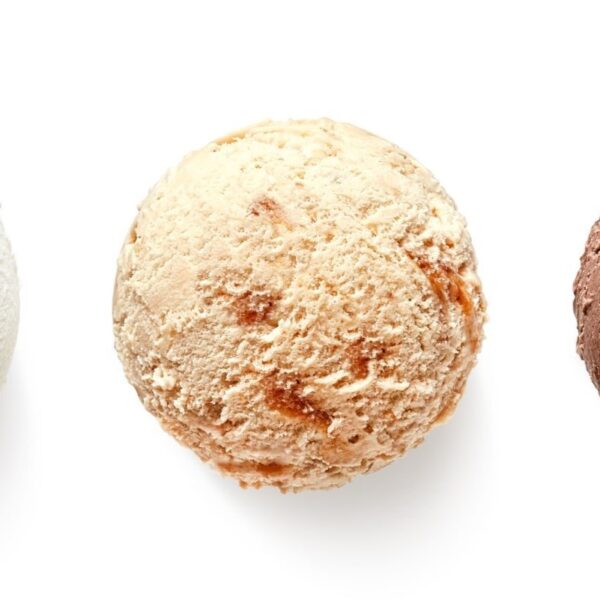Fructooligosaccharides (FOS) are indigestible and highly fermentable oligosaccharide fructans that occur naturally in foods such as onions, bananas, tomatoes, garlic, and wheat. They are made up of short chains of fructose molecules linked together by β-(2-1) glycosidic bonds that human digestive enzymes cannot break down. As a result, FOS pass through the digestive system largely intact, providing several health benefits along the way. Fructooligosaccharides can be produced commercially and are used as an additive in many food products and nutraceuticals.
What are Fructooligosaccharides?
Fructooligosaccharides (also known as oligofructose or oligofructan) consist of linear chains of d-fructose units linked by β(2 → 1)-glycosidic bonds, having a terminal d-glucosyl unit linked to a fructose molecule by an α(2 → 1)-bond.
Source: Wikipedia
Chemically, FOS are oligosaccharides, meaning they consist of several sugar molecules linked together. The number of fructose units in FOS can vary, typically from two to nine. FOS with two to 10 units are known as fructooligosaccharides. FOS and inulin are classified based on their DP (degree of polymerization) based on the number of monosaccharide units. FOS has a DP <10, while inulin has a DP between 10 and 60. Inulin is a type of soluble dietary fiber that is also found in certain plants, such as chicory root.
How are Fructooligosaccharides Produced?
Inulin and oligofructose are industrially produced either enzymatically through fructosyltransferase action on sucrose or by extraction from specific plants or plant parts such as chicory (Cichorium intybus) roots.
Applications of Fructooligosaccharides in Food & Nutrition
FOS have several functions in food products:
| Function | Description |
| Sweetener | FOS have a sweet taste, similar to sugar, but with fewer calories. They can be used as a natural sweetener in food and beverage products, providing sweetness without raising blood sugar levels and caloric load. |
| Bulking Agent | FOS can be used as a bulking agent in food products, providing texture and volume without adding significant calories. They can be particularly useful in low-calorie or reduced-sugar products. |
| Prebiotic | FOS act as a prebiotic, which means they promote the growth of beneficial bacteria in the gut. They specifically stimulate the growth of Bifidobacteria, considered “friendly” bacteria that help maintain a healthy balance of microorganisms in the gut. |
| Humectant | FOS can act as a humectant in food products, which means they help retain moisture and prevent products from drying out. They can be particularly useful in baked goods and other products where moisture retention is important for texture and shelf life. |
| Fiber Source | FOS are considered to be a type of dietary fiber. Human digestive enzymes do not easily break them down, so they pass through the digestive system largely intact. |
| Viscosity Modifier | FOS can act as a viscosity modifier in food products, helping to thicken or stabilize formulations. |
Product Examples in the Food Industry
| Type | Examples |
| Bakery | Bread, Muffins, Cakes, Pastries |
| Dairy | Yogurt, Milk, Ice Cream, Cream Cheese |
| Beverages | Fruit Juices, Smoothies, Protein Shakes |
| Snacks | Granola Bars, Energy Bars |
| Cereals & Breakfast Products | Cereals, Oatmeal, Breakfast Bars |
| Spreads and Jams | Fruit Spreads, Nut Spreads |
| Chocolates & Confectionery | Chocolates, Candy Bars |
| Frozen Dessert | Frozen Dessert, Popsicle, Sorbet |
| Baby Foods | Pureed Fruits and Vegetables, Cereal, Snack Puffs |
Product Examples in the Food Industry
| Type | Examples |
| Prebiotic Supplements | Prebiotic Mixes, Symbiotic Mixes |
| Digestive Health supplements | Fiber Supplements |
| Weight Management | Meal Replacement Shakes |
Fructooligosaccharides for Special Dietary Needs
- Diet for diabetics: FOS do not cause a spike in blood sugar levels and can be used to replace sucrose in food for diabetics to a certain extent.
- Diet for weight management: FOS contribute fewer calories when used to replace sugar or other high-calorie bulking aids, making them ideal for use in food products for people watching their weight.
- Diet for constipation: FOS serve as dietary fiber, improving the bulk of stool and assisting with digestive health.
Properties of Fructooligosaccharides
| Physical Form | Powder, syrup |
| Color | White |
| Odor | Fruity smell |
| Taste | Sweet taste |
| Storage Temperature & Conditions | 2-8°C in airtight container |
| Molecular Weight | 1000 to 5000 Da |
| Bulk Density | 400-600 g/L |
| Viscosity (60%) | 100 mPa |
| Solubility | 80 g/100 ml |
| Claims (*Product Specific) | Halal*, Kosher*, Non-GMO* |
Typical Formulations
Symbiotic Ice Cream
Here is an example of an ice cream formulation with fructooligosaccharides, along with the weight of ingredients:
| Ingredient | Composition (g) |
| Milk powder | 50 |
| Milk | 1000 |
| Probiotic (L. casei) | 1 |
| Cream | 150 |
| Sugar | 50 |
| Vanilla | 1.5 |
| Salep | 5 |
| Fructooligosaccharides | 100 |
The use of prebiotics (fructooligosaccharides) may improve the nutritional quality of the end product via the inclusion of fibers and being a low-energy alternative ingredient for the fat molecules of the end products.
Source: IFST
Strawberry Jam
Here is an example of a strawberry jam formulation with fructooligosaccharides, along with the weight of ingredients:
| Ingredient | Composition (g) |
| Strawberry pulp | 300 g |
| Sorbitol | 100 ml |
| Orange juice | ¼ of Orange |
| Orange peel zest | ¼ of Orange |
| Cinnamon stick | ½ stick |
| Pectin | 3.6 g |
| Calcium chloride | 35 g |
| Sorbate | 0.5 g |
| Benzoate | 0.5 g |
| Fructooligosaccharides | 300 g |
Sucrose in jams can be replaced with sorbitol and fructooligosaccharides to develop jams with improved nutritional properties, maintaining the characteristics of the jam in terms of texture and flavor.
Source: Hindawi
Mixed Prebiotics
Here is an example of prebiotic mix formulation with fructooligosaccharides, along with the ratio of ingredients:
| Ingredient | Ratio |
| Inulin | 1.33 |
| Fructooligosaccharides | 2.0 |
| Glucooligosaccharides | 2.67 |
The various prebiotics used in this formulation can stimulate the growth of probiotics and enhance their function.
Source: MDPI
Coconut Cookie
Here is an example of a cookie formulation with fructooligosaccharides, along with the % weight of ingredients:
| Ingredient | Composition (%) |
| Refined wheat flour | 41.6 |
| Sugar | 5.0 |
| Margarine | 16.0 |
| Coconut flakes | 8.0 |
| Eggs | 7.2 |
| Whole milk | 5.2 |
| Vanilla extract | 2.0 |
| Fructooligosaccharides | 15 |
FOS were used in these cookies to improve the sweetness, fiber content, and prebiotic content of the final product.
Source: Research Gate
Fructooligosaccharides Formulation Considerations
| Physical Forms | Powder, syrup |
| Stability | FOS are very thermostable at neutral pH (up to 110°C) while more labile at acidic pH. |
| Nutritional Profile | 1.0-1.7 Cal/g |
| Sensory Attributes | Sweet taste |
Variants of Fructooligosaccharides
Chain Length
Oligosaccharides are oligomers made up of two to 10 monosaccharide residues structurally connected by glycosidic bonds. The functional properties of oligofructose depend mainly on the degree of polymerization (DP). Short-chain fructooligosaccharides occur in many edible plants, such as chicory, onions, asparagus, and wheat. They are a group of linear fructose oligomers with a degree of polymerization ranging from n = 1 up to 5 (oligosaccharides).
Fructooligosaccharides and inulin are both types of dietary fibers that are classified as prebiotics. FOS are composed of short chains of fructose molecules, while inulin is composed of longer chains of fructose molecules.
Degree of Sweetness
The sweetness of FOS is 0.4 to 0.6 times sucrose. It has also been observed that FOS with longer chains are less sweet. Generally, FOS with a lower DP, meaning a smaller number of fructose units, tend to be sweeter. This is because the sweet taste receptors on the tongue more easily recognize shorter-chain FOS molecules. As the DP of FOS increases, the sweetness tends to decrease. Longer chain FOS molecules are less easily recognized by the sweet taste receptors, resulting in a less pronounced sweet taste.
Effects of FOS on Properties of Food Products
Rheological Properties
FOS solutions typically have a low viscosity and flow easily at low concentrations. As the concentration increases, the viscosity of the solution also increases, resulting in a thicker and more viscous consistency. This can affect the texture and mouthfeel of food products that contain FOS.
FOS syrups have a thicker and more viscous consistency. They can be sticky and have a syrup-like texture, similar to honey or maple syrup. FOS syrups are commonly used as sweeteners or binders in various food products, such as bars, beverages, and baked goods. The syrupy texture of FOS can contribute to these products’ overall mouthfeel and stickiness.
Textural Properties
A study observed that FOS can successfully slow down the crystallization of starch and yield softer breads with longer shelf life. Bread with SC-FOS has shown better water retention and modulation of water mobility.
Nutritional Properties
Short-chain fructooligosaccharides, to a large extent, escape digestion in the human upper intestine and reach the colon, where they are completely fermented — mostly to lactate, short-chain fatty acids (acetate, propionate, and butyrate), and gas. Due to their fermentation, their caloric value is approximately 2 Kcal/g.
An important property of short-chain fructooligosaccharides is the stimulation of Bifidobacterial growth specifically while suppressing the growth of potentially harmful species, such as Clostridium perfringens, in the colon.
They are also associated with a decrease in fecal pH, an increase in fecal or colonic organic acids, a decrease in the production of nitrogenous end products in urine and stools, a decrease in fecal bacterial enzymatic activities and a modification in fecal neutral sterol.
Safety and Regulatory Considerations
| FDA Information | In accordance with 21 CFR 170.30, FOS have been determined to be Generally Recognized as Safe (GRAS) based on scientific procedures. |
| EU Information | FOS have been approved in the European Union for addition in restricted amounts to infant formula (for babies up to six months) and follow-on formula (for babies between six and 12 months). |
Health Effects of Fructooligosaccharides
| Health Benefits | Description |
| Prebiotic Effect | Fructooligosaccharides are not excreted in the feces, which indicates that they are thoroughly fermented in the colon. Bacteria produce glycolytic enzymes that hydrolyze FOS into mono- or disaccharides, which are transported to the interior of the cell, where they are metabolized to SCFAs. |
| Relief from Constipation | The end products of FOS fermentation by the bacteria of the colon, SCFAs, are absorbed and used by the cells of the human colonic epithelium, stimulating their growth as well as the absorption ofsalts and water, which increases the humidity of the cecal bolus through osmotic pressure, resulting in increased intestinal motility. |
| Effect on Mineral Absorption | FOS have been demonstrated to have a positive effect on theabsorption of calcium, magnesium, iron, and zinc. During fermentation of the soluble fiber in the colon, the bound or sequestered minerals are released and become available for absorption. Also, FOS reduce the pH of the colon and increases the solubility/availability of the minerals, particularly of calcium and magnesium. |
| Hypoglycemia | It has been observed in rats that a diet supplemented with 10% oligofructose for 30 days reduces postprandial glycemia and insulinemia by 17% and 26%, respectively. |
| Immune system modulation | The activities of FOS include immunoregulation of the intestinal secretion of IgA and interferon (IFN)-γ through the Peyer plates, the increased expression of polymeric immunoglobulin receptors in the small intestine of suckling mice, and the development of gut-associated lymphoid tissue associated with the intestine. |
Identification Numbers
| CAS Number | 308066-66-2 |
| EINECS | 204-465-2 |
Fun Facts About Fructooligosaccharides
- Unlike some other sweeteners, fructooligosaccharides are relatively stable under heat, making them suitable for use in cooking and baking.
- FOS can be extracted from the blue agave plant and bananas, onions, garlic, asparagus, jícama, leeks, wheat, and barley.








